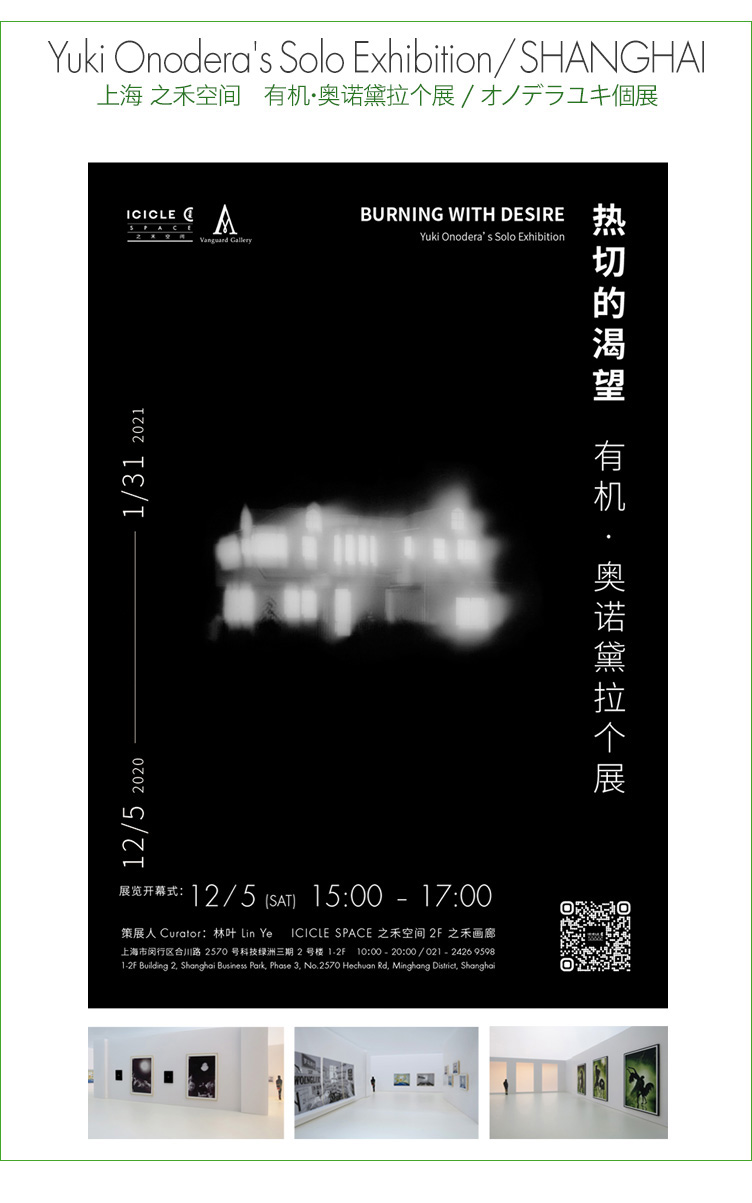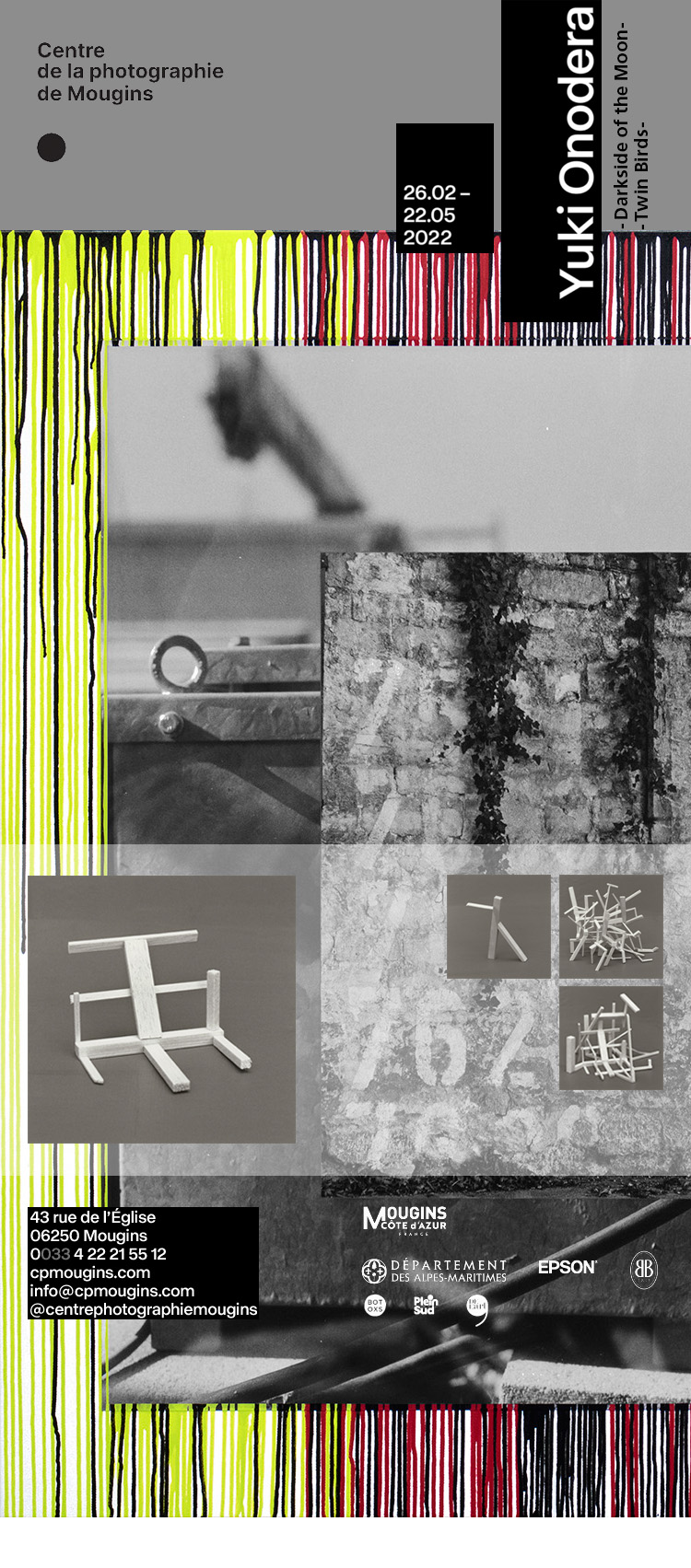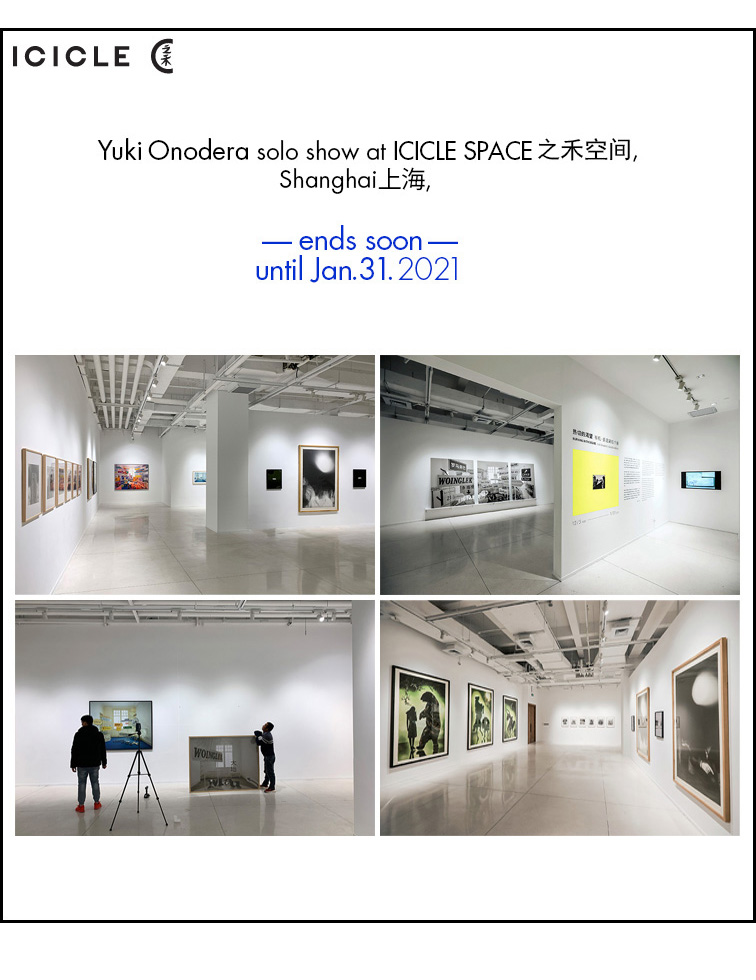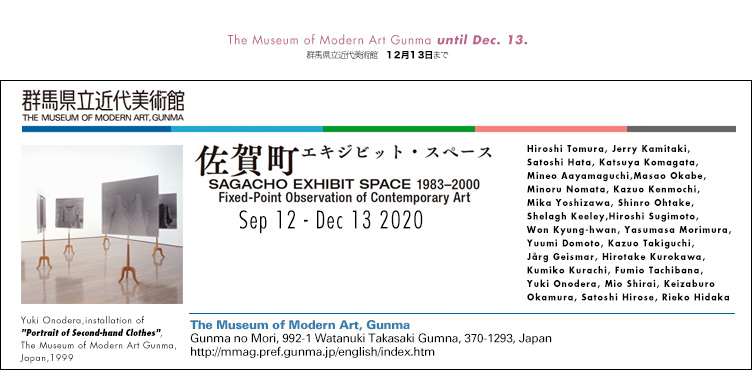
热切的渴望 有机·奥诺黛拉个展
"Burning with Desire" Yuki Onodera’s Solo Exhibition
12/5 ~ 1/31 2021
开幕式 Opening Ceremony
12/5 15:00- 17:00
策展人 Curator:林叶 Lin Ye
ICICLE SPACE 之禾空间2F 之禾画廊
上海市闵行区合川路2570号科技绿洲三期2号楼 1-2F
open:10:00-20:00
t: 021-24269598
1-2F Building 2, Shanghai Business Park, Phase 3, No. 2570 Hechuan Rd, Minghang District, Shanghai
Exhibition Preview | "Burning with Desire" Yuki Onodera’s Solo Exhibition
Since December 5th, Burning with Desire, the solo exhibition of Yuki Onodera, will make its first debut in Icicle Space. Striving to bring people back to the world of photography. in the era of image-dominated worship of technical images, this exhibition aims to sort out and ponder over people’s cognition of images and the relationship among human beings, the world and images. The exhibition will last until January 31, 2021.
https://mp.weixin.qq.com/s/iL-YPmTzpbeZM4afORiZFw
Preface to the Exhibition
Burning with Desire
In an 1828 letter to his partner, Nicéphore Niépce, Louis Daguerre wrote, "I am burning with desire to see your experiments from nature." Here, what he longed for was photography. In the summer of 1827, Niépce shot the scenery outside the window in natural light with hand-made photographic plates which were coated with the mixture of wax and asphalt. After eight hours of exposure, he got the first photo in human history called View from the Window at Le Gras.
Although this photo is not as clear as the one taken by Daguerre in 1839, its significance lies in that the dream to copy real things by mechanical technology that a large number of scientific researchers had been fighting for in those days, seems to be possible. This photo leads human beings to a new world. From then on, their cognition of surroundings no longer depends on magic, but on imagination based on reality. The images that originally exist in camera bellows are shown to the public, serving as the carriers of information which can be spread every corner of the globe; meanwhile, their edition and extraction of the real world have fragmented our cognition, thus changing our consciousness imperceptibly and thoroughly.
It is probably the magical power of photography that makes Daguerre burn with desire. The metaphor of burning desire refers to both technology and mankind’s cognition - human's keen desire to imagine realistically. Driven by such a desire, we, human beings, have witnessed a great leap of images, such as portraits, films, pictorials, television. Within less than two centuries, we are now surrounded by images. Our cognition also keeps changing in the world of images. Images are the important channels of communication in daily life and work, a medium to know the real world, and even to a certain extent, the virtual substitutions of real objects. Nowadays, we are more convinced that viewing images is to see the world itself, rather than to observe and learn about the world through images. Due to the blind worship of technical images, people have been gradually reduced to their slaves who copy and imitate the images during their production and dissemination. The image is no longer a medium to help human beings to understand the world, but a tool to control people.
Today, standing at the crossroads of seeking for photography, we have to reconsider its true meaning, and the relationship among photography, human beings and the world. In my point of view, Yuki Onodera’s exhibition aims to encourage people to face up to the questions mentioned above. The exhibition starts with Niépce's View from the Window at Le Gras, which draws people back to the world of photography; and then, constructs a network with a large number of photographic works. Immersing ourselves in it, we can feel the relationship between human beings and photography, or photography and the world. If Daguerre's desire in 1828 is to develop a technique and narrate history with images, the desire inspired by Yuki Onodera’s exhibition, in the era of image-dominated worship of technical images, might be something that requires recognition of images and reorganization of relations among human beings, photography and the world.
Curator: Lin Ye
One of the important propositions of Yuki Onodera's artistic creation is to trace and re-examine the history of photography. In this solo exhibition, five series of her works will be displayed, namely, The World Is Not Small -- 1826, How to Make a Pearl, Look out of the Window, Portrait of Second-hand Clothes, as well as Annular Eclipse. All of these have shown the relationship between image cognition and people, and the world from various angles.
-----------------------------------------------
Yuki Onodera
Yuki Onodera was born in Tokyo, Japan in 1962. Now lives and works in Paris.
Yuki Onodera is an artist who masters photography that takes form in contemporary art. She uses methods such as clipping newspaper and machining the works while completing her creation using silver salts photography. She uses any possible method to realize her works, whether this means taking photographs with a marble inside her camera or creating a story out of a legend and travelling to the ends of the earth to shoot it. Onodera’s experimental works, which does not fit within schemas of “photography” often poses two questions: what is photography, and what can be done through it? Her works are held in collections around the world, including those of Centre Georges Pompidou, San Francisco Museum of Modern Art, The J. Paul Getty Museum, Shanghai Art Museum and Tokyo Metropolitan Museum of Photography.
Curator: Lin Ye
Art critic and translator. He is Mainly engaged in the research of visual culture and translation of photography theory. His translations include the collection of Hiroshi Sugimoto's "The Origin of Art", "Phenomena", "50 Years of Japanese Photography", "Private Photography Theory", and selected translations of "Japanese Art Photography History". Articles were published in ARTFORUM, Tencent·Guyu, The Paper, "The Thinker Weekly", "Art Contemporary", Ray Art Centre, "Shu Town", "Chinese Photography" and other media.
Vanguard Gallery
Vanguard Gallery is founded in 2004 in Shanghai. The gallery is devoted to discover and promote emerging contemporary artists since its establishment. With immensely open attitude towards artistic creation in different forms, Vanguard Gallery has served as a platform for exposure and practice for young artists, and has discovered many of whom are active participants today in constructing the Chinese contemporary art discourse system. In recent years, the gallery is focusing more on conceptual art specifically despite medium, nationality or times. Artists from different countries and generations have joined Vanguard, which provides a diverse selection of works both in forms and concepts.
Through the persistence in supporting and promoting conceptual and experimental artistic creations, Vanguard Gallery has become a significant force in setting the trend and exploring the possibility of contemporary art’s future in China.
12月05日起,"热切的渴望"有机·奥诺黛拉个展将于之禾空间与公众见面。这次的个展旨在将人们重新拉回到摄影的大门口,在这个由影像主导,形成顽固的技术性影像崇拜的时代里,对于影像的认知、人与影像、世界与影像的关系进行一次梳理与思考。展览将持续至2021年01月31日。
展 览 序 言
热切的渴望
1828年,路易·达盖尔给尼塞福尔·尼埃普斯写了一封信,信中他这样说道:“我怀着热切的渴望,想看到你用大自然做的实验。”在这里,他渴望的对象正是“摄影”。 就在一年前,1827年夏天,尼埃普斯在铅锡合金板上涂上白蜡和沥青的混合物,做成感光板,利用阳光和原始镜头,拍摄窗外的景色,经过长达八小时的曝光,获得了人类拍摄的第一张照片《窗外风景》。虽然这张照片并不像1839年公布的达盖尔摄影术拍摄的照片那样清晰细致,但是这张照片却意味着当时大量科学研究者所努力想要实现的事情,通过机械技术将现实事物如实地复制下来将成为可能。这张照片为人类打开了一扇神奇的窗口,从此以后人类对世界的认知不再依靠魔法而是 通过真实的依据进行想象。于是,原本存在于暗箱之中的影像被明室化了,成为可以在世间传播的信息载体;然而影像也开始对现实世界进行裁切、提取,让我们对现实的认知片断化,在无形中对我们的意识进行彻底的改造。
或许让达盖尔燃烧起“热切的渴望”的,正是摄影所具有的这种神奇力量。显然这 种渴望的隐喻不仅可以指向科学技术,同时也可以指向人类的认知意识——人们渴望实在地进行想象。也正是在这种“渴望”的推动下,我们迎来了影像的大发展, 肖像照、电影、画报、电视……在短短不到两百年的时间里,我们已经完全被影像所包围。我们的认知也在影像构成的拟像世界中逐渐发生变化。影像不仅是我们日常生活与工作中沟通交流的一个重要手段,认识现实世界的一个媒介,甚至在一定程度上取代了现实世界成为了一个拟真的存在,我们不再通过影像进行观看并认知世界,而是认为观看影像就是在观看世界本身。这样技术性影像的崇拜,让人逐渐沦为影像的奴隶,在影像生产与传播中不断复制并模仿影像。影像已经不再是帮助人们理解这个世界的媒介了,相反成为一种控制人的工具。
今天,我们再一次站在了寻找“摄影”的十字路口,需要重新去考察摄影究竟是什么?摄影与人的关系是什么?摄影与世界的关系又是什么?在我看来,有机·奥诺黛拉的这个展览就是要促使人们直面上述这几个问题。展览从尼埃普斯的《窗外风景》开始,将人们拉回到摄影的大门口,并通过大量的作品建构出围绕摄影展开的关系网络,让人置身其中,感受我们与摄影的关系、理解摄影与世界的关系。如果说,1828年达盖尔怀揣的是一种对技术的渴望,一种用影像叙述历史的渴望,那么有机·奥诺黛拉这个展览所激发的,可能是一种在影像一统天下,形成顽固的技术性影像崇拜的时代里,重新认知影像、重新梳理人与影像、世界与影像关系的渴望。
策展人
对摄影史的追溯与再考是Yuki Onodera艺术创作的重要命题之一。在这次的个展中,带来了Yuki Onodera五个系列的作品,它们分别是:世界并不小—1826、如何制作一颗珍珠、看窗外、二手衣服肖像、日环食。这些系列从不同角度向我们展现了影像认知与人,与世界的联系。
Yuki Onodera
有机·奥诺黛拉
1962年出生在日本东京,现生活工作在法国巴黎。
有机·奥诺黛拉是一位以当代艺术的方式驾驭摄影的艺术家。她会采用剪报等手法来制作作品,对照片进行加工的同时也用银盐摄影来创作;她曾将玻璃球放入相机之中进行拍摄,根据事件与传说来构建故事、并据此来到地球的背面进行拍摄等等。对她而言,照片不仅仅只是素材,而是应该对其本质进行探求的对象,她运用所有的手法,创作了很多探讨“摄影是什么”、“摄影的意义是什么”等问题的实验性作品,并发表了很多独特的、不为摄影这个框架所限制的系列作品。她的作品被蓬皮杜中心、旧金山当代艺术博物馆(SFMoMA)、保罗盖蒂美术馆、上海美术馆、东京都摄影美术馆等世界各地的多家美术馆收藏。
策 展 人
林 叶
艺评人、译者。主要从事视觉文化的研究与摄影理论翻译工作,译作有杉本博司文集《艺术的起源》、《现象》、《日本摄影50年》、《私摄影论》,选译《日本艺术摄影史》等。文章发表于ARTFORUM、腾讯·谷雨、澎湃、《信睿周报》、《艺术当代》、瑞象视点、《书城》、《中国摄影》等媒体。
联 合 承 办
Vanguard 画廊2004年创立于上海。创建伊始画廊以发现和支持从事当代艺术创作的青年艺术家为主要方向。抱持着极大的开放性,Vanguard为年轻艺术家们提供展示和实践的平台,发掘了不少目前中国当代艺术语境中的活跃参与者。近年来,画廊将目光更清晰地锁定在观念艺术方向,艺术家创作类型多样,且加入了来自不同的地区和不同时代的艺术家,使作品无论从形式或概念上都更加多元。
自创办以来,Vanguard画廊坚持对观念性实验性艺术创作的支持和推广,已成为中国探索并实践当代艺术未来走向与可能性的重要力量。
*
*
*
*
*
*
*
*
*
*
*
*
*
*
*
*
*
*
*





